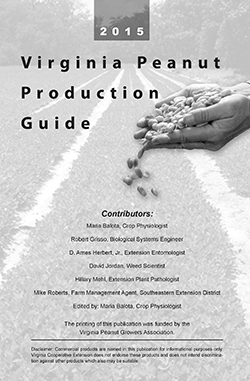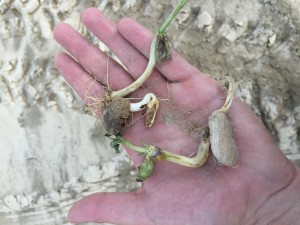Virginia state peanut meeting is scheduled for February 10, 2016, at 9:00 am at the Airfield 4-H Conference Center in Wakefield, VA (15189 Airfield Rd, Wakefield, VA 23888
(757) 899-4901; http://www.airfieldconference.com/). See you there!
Category Archives: Peanut
More News on Peanut
I attached here two documents. One is the latest JLA update on peanut with information covering Virginia-Carolina region JLA Report_Oct 15. The second is an update by state by Spearman Agency 2015 TS Peanut News.
Virginia Peanut Latest News
In Virginia peanut digging started this year two weeks earlier than in most years, on Sep 15 in most counties. This is because of the combination of genetics, early maturing cultivars, and weather. One may say this summer was dry. Indeed, it was and some fields were more affected by drought than others. But it was a certain type of drought: cool and wet alternating with warm and dry long periods of time. For example, May was warm and dry, and suitable for early flowering; June and half of July were cooler and moist; perfect for peg and pod growth. And that was it: one huge, uniform crop set early on in the season and not two crops like we usually see in dry years. Altogether, by mid Sep the 2600 accumulated heat units were sufficient for Bailey and Sugg, the mostly grown cultivars in Virginia this year, to mature.
Over 85% of the peanuts in Virginia have been dug and in most part picked by now. Yields of those picked before Joaquin and dug after the storm are in 4,000 lb/ac yield and grades are good. Peanuts dug right prior to Joaquin are in good shape, but a lot of pod shedding occurred and this will reduce yield. The peanuts dug a week ahead of storm are in poor shape and some segregation 2 peanuts with a high content of damaged kernels was sold. No segregation 3 was yet reported. A lot of sprouting was also observed.
Stop peanut digging until frost potential passes
Due to the frost and freeze advisories in effect from Sunday through Tuesday night (Oct 19 through Oct 21) in the V-C region, I recommend that peanut digging be stopped after today (Thu, Oct 15). Peanuts will need three days to dry in order to not be affected by frost. Resume digging only after temperatures become milder.
Frost advisory is available at http://webipm.ento.vt.edu/cgi-bin/listfrost
Virginia Frost Advisory
The Virginia Frost Advisory predicts that a frost is expected next Monday morning (10/19) for Suffolk, Capron, Waverly, Skippers, and Lewiston. A copy of the report can be downloaded below. For up-to-date frost advisories for the region, see the Peanut-Cotton Infonet (http://webipm.ento.vt.edu/cgi-bin/listfrost).
Unusual yellow peanut color
I have recently seen several peanut fields or spots in the fields around the Tidewater AREC with yellow plants resembling nitrogen deficiency. Colleagues in North Carolina are also getting concerned with peanuts needing late season nitrogen applications. Similarly, in one of my research fields we noticed a part of the field with yellow plants resembling nitrogen deficiency next to dark green plants for the rest of the area. Indeed, early this summer Kelvin Wells, Extension Agent in Sussex county VA, brought in some samples of yellow peanut plants. Right away I identified nitrogen deficiency because there were no nodules on the roots and plants were starting blooming; also the farmer did not inoculate at planting. It was easy. But with the plants from my own field trial it is not so easy! Yellow and smaller plants had larger nodules than the bigger and greener plants and in a similar number on July 17 when I checked. Nodules from both plants, green and yellow, were dark red when cut, indicating active nitrogen fixation (pictures are attached here Unusual peanut color). The green plants were planted on May 10 and the yellow ones on May 22. I really do not have any other explanation than probable negative effect of high temperatures and dry conditions experienced by late planted peanuts in Virginia this year. This could have affected root growth and nodulation for young seedlings and carried nutritional imbalances over to later stages.
Peanut Disease Update
Recent warm, wet weather has been optimal for both plant growth and fungal disease development in peanut and other crops. Early planted peanut in southeastern Virginia is near the R3 (beginning pod) stage, so it is almost time to make the first fungicide application for leaf spot. The first spray can be delayed until two weeks after R3 on Bailey. Last effective spray dates for leaf spot can be found on the Virginia Peanut-Cotton Infonet website.
Sclerotinia blight risk in based on temperature, rainfall/humidity, and crop growth. Temperature and rainfall have been conducive for Sclerotinia blight, but Sclerotinia risk is considered low to moderate prior to canopy closure. However, rapid growth of the peanut crop in some fields has resulted in thick canopies that provide the moist micro-climate necessary for disease development. Thus, now is the time to start scouting for Sclerotinia blight in peanut fields, especially if vines are within six inches of touching. If the wet weather continues, Sclerotinia blight risk is expected to be high within the next couple of weeks.
The Virginia Peanut-Cotton Infonet has moved (back)
The Virginia Tech Tidewater AREC (TAREC) maintains the Peanut-Cotton Infonet which provides growers in the region with daily weather data (e.g. temperature, rainfall), peanut leaf spot and Sclerotinia advisories, peanut heat units, cotton degree days, and a frost advisory. Four weather stations located in Suffolk, Capron, Skippers, and Waverly are maintained by the TAREC Plant Pathology program. These weather stations transmit data to a computer at the Tidewater AREC, and the data is used to run fungicide advisory models. Data are available on the Virginia Peanut-Cotton Infonet website (http://webipm.ento.vt.edu/cgi-bin/infonet1.cgi).
The data and information available here include:
Maximum, minimum, and average air temperatures
Average soil temperature at a 4 inch depth
Daily and accumulated (from May 1) peanut heat units
Daily and accumulated (from May 1) cotton degree-days
Daily and total seasonal (from May 1) rainfall
Last effective spray date for peanut leaf spot
Sclerotinia blight risk
Frost advisory (from September 25th to completion of harvest)
In addition to the data provided on the Infonet, current information on peanut diseases in the region and disease management recommendations will be provided here on this blog, so be sure to check back for updates.
Virginia Peanut-Cotton Infonet Update
The Virginia Tech Tidewater AREC (TAREC) maintains the Peanut-Cotton Infonet website (webipm.ento.vt.edu/infonet/) which provides growers in southeast Virginia with daily weather data (e.g. air and soil temperatures, rainfall, relative humidity), peanut leaf spot and Sclerotinia advisories, peanut heat units, cotton degree days, and a frost advisory. Four weather stations located in Suffolk, Capron, Skippers, and Waverly are maintained by the TAREC Plant Pathology program. Thanks to funding from the Virginia Peanut and Cotton Boards, we have been able to upgrade our equipment which should improve the overall reliability and consistency of data transfer from our weather stations. The new equipment has been installed and we are receiving data, but we are temporarily unable to post the data to the Infonet website. This technical issue should be resolved by next week, but in the meantime daily weather data will be sent out as an email to extension agents and posted to the Virginia Ag Pest Advisory Blog. We apologize for the inconvenience, and we are working hard to get the Peanut-Cotton Infonet website up and running for the season. If you have any questions or concerns feel free to call the TAREC Plant Pathology lab at (757) 657-6450 ext. 428 or email Dr. Hillary Mehl (hlmehl@vt.edu).
Please find below the current weather data for Suffolk, Capron, and Skippers. The Waverly data will be available shortly.
Getting Ready for a New Peanut Season
Variety selection. For Virginia and Carolinas (VC) the preferred Virginia market-type cultivar was Bailey followed by Sugg, in 2013 and 2014. Both have good disease package, Bailey more than Sugg, but none has the high oleic trait. This may not be a major concern for farmers (even though I hear that shellers pay premiums for the high oleic cultivars) but is increasingly so for shellers, processors and, most importantly, consumers. High oleic oil profile alternatives with very good disease resistance are Sullivan and Wynne, 2013 releases. Sullivan is similar in seed size with Bailey and yielded better than Bailey in variety trials across the VC region in 2014. It was more resistant to diseases than Bailey, too (credit to Dr. Mehl). Wynne is a larger seeded cultivar, larger than Sugg, with excellent yields in 2013. Seed of Sullivan and Wynne may not yet be abundantly available to farmers but, if you can get some, I encourage you to try these two new cultivars this year.
Potash. This note was inspired by some of Dr. Jordan’s notes to the Extension Agents in North Carolina. For some growers, soil test results recommended application this year of potash for peanut and they did not know what to do. Usually, potassium is not a common application for peanut but, due to excessive soil moisture we have had in 2014 and up to now, potassium may have been leached through the soil profile. I have a similar situation in my own backyard. If the soil tests recommend potash application, do so. Of course, make sure after this to apply the required rate of gypsum at the optimum recommended time by the VA Peanut Production Guide. VA Peanut Guide 
Inoculant. Here we are again! Remember last year when we recommended applying inoculant regardless the number of years of peanut rotation? It was because too much water standing in the field and we speculated that this could have killed the bacteria. Do the same this year. Trials conducted by Dr. Jordan in North Carolina from 1999 through 2014 showed 1,565 lbs/acre yield increase in new peanut land and almost 200 lbs/acre in regular peanut fields by applying in-furrow liquid or granular inoculant. For best results however, the inoculant needs to be delivered right on top of the seed and not on the soil aside. We use Optimize Lift brand mixed with Admire-Pro and Proline for several years, just like Dr. Herbert’s group. Ammonium sulfate did not increase yield relative to the no-inoculant and no-ammonium sulfate treated controls in half of the tests conducted by Jordan in North Carolina.



